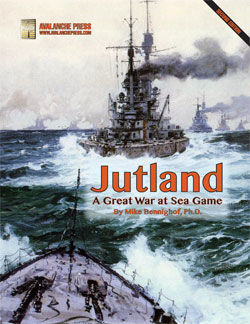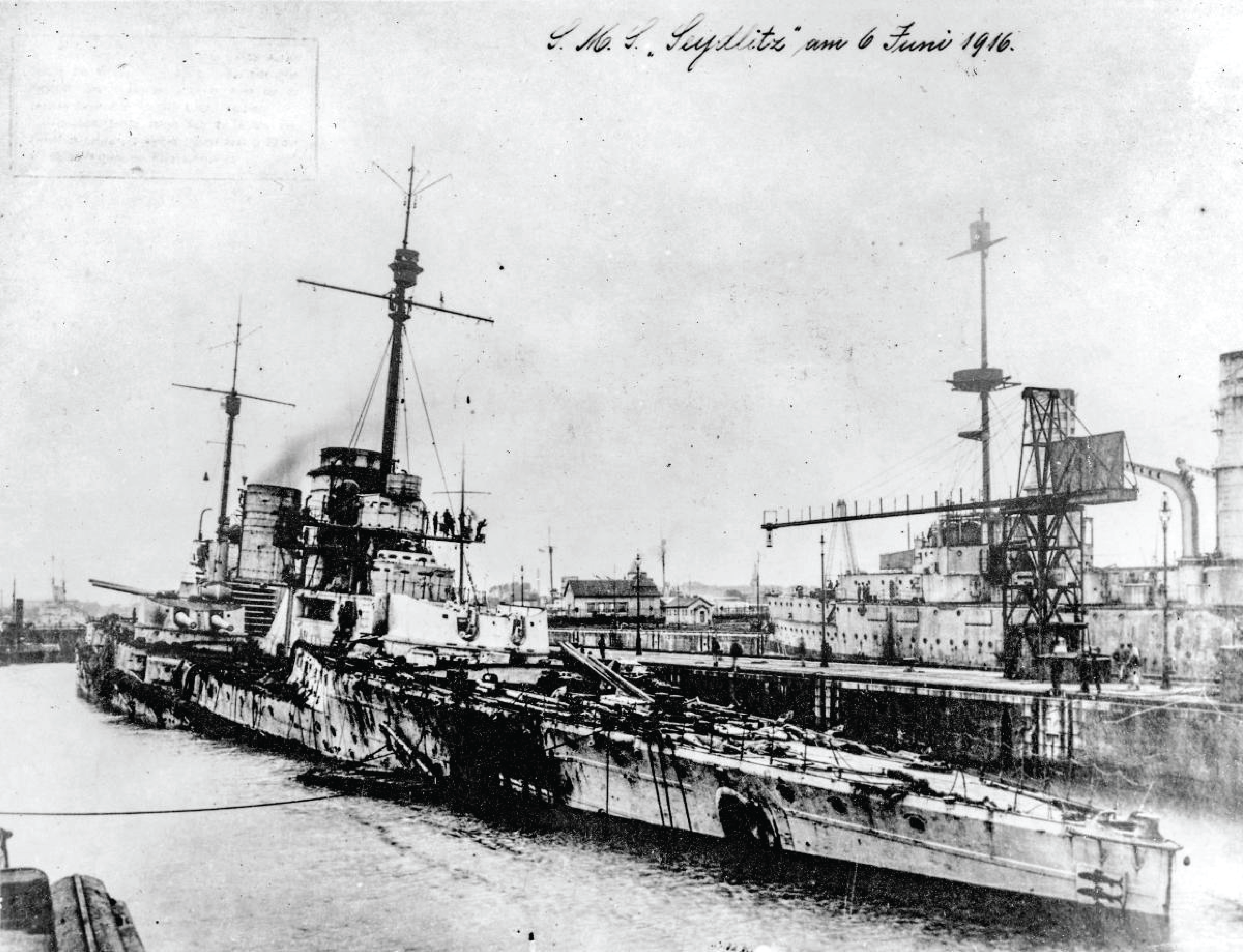| Jutland:
The Battle, Part Seven:
After the Great Battle, Part One
By Mike Bennighof, Ph.D.
June 2024
 The High Seas Fleet returned to Wilhelmshaven following the Battle of Jutland, at the peak of its morale. The Germans claimed victory, and British acknowledgement of their own severe losses helped reinforce the impression. The High Seas Fleet returned to Wilhelmshaven following the Battle of Jutland, at the peak of its morale. The Germans claimed victory, and British acknowledgement of their own severe losses helped reinforce the impression.
“The fleet is absolutely enthusiastic,” Austro-Hungarian naval attaché Hieronymus Colloredo-Mansfeld reported to Vienna, “and intoxicated with victory.”
The glow soon wore off the victory as word of German losses filtered out, especially the battle cruiser Lützow, the gleaming new flagship of the Scouting Forces. At least most of her crew had returned home to tell their stories. The pre-dreadnought Pommern had left no survivors to tell of her loss, and the light cruisers Frauenlob and Wiesbaden had just ten survivors between them.
The fleet had enthusiasm, but it also had a great deal of damage, much more than German dockyards could easily repair. Von der Tann, the oldest of the battle cruisers, had finished the battle with no operable heavy guns – they had overheated and the crew’s solution, applying fire hoses to cool them enough to keep firing, had only worked for a short while. Alsen turret, the forward mount, had been destroyed and the dockyard pulled D turret from the dreadnought Rheinland, undergoing repair for minor damage, to replace it. Von der Tann would be under repair for two months, returning to service on 15 August after working up and training.
Moltke likewise would spend two months under repair, in the Blohm und Voss commercial shipyard where she had been built. She left the shipyard on the same day von der Tann completed her own repairs, and returned to service on 14 August.
Seydlitz had taken enormous damage, 26 shell hits plus one from a torpedo, one more than the squadron flagship Lützow, which sank on the way home thanks to progressive flooding. Seydlitz suffered similar flooding and only barely reached Wilhelmshaven, after falling in with the three Queen Elizabeth-class fast battleships of the British Fifth Battle Squadron and convincing them that she was also British, her signals crew having noted British recognition flashes during the battle. Seydlitz immediately entered the floating dock and remained under repair until 2 October, and she returned to service only on 3 November with a concrete patch on the roof of Turret B.
Derfflinger, the Iron Dog herself, absorbed an astonishing 31 shell hits, and made it back under her own power. After some minor work in Wilhelmshaven, she went to Kiel’s imperial dockyard and stayed there until 15 October. After trials and training, she re-joined the High Seas Fleet on 20 November.
König suffered more damage than any other German battleship, taking 10 hits from heavy shells and remaining in dockyard hands until 21 July. Her sister Grosser Kurfürst took eight heavy shell hits, and suffered extensive flooding. She went to AG Vulkan’s commercial in Hamburg and stayed there until 16 July. Markgraf, hit five times, joined her sister at AG Vulkan and exited the yard on 20 July. No other German capital ship suffered more than two hits.

Battle cruiser Seydlitz made it home in this condition, and saw action again.
Reinhard Scheer hoped to challenge the Grand Fleet again, but the extensive damage meant that a new sortie would not take place for at least two months. During that time, he and his staff evaluated the battle’s results. They had been very fortunate not to face far greater losses; at several points, the action could have swung decisively in favor of the British. Scheer’s hope had been to catch just part of the Grand Fleet alone and annihilate it, and he continued to think along these lines – but he would have to find new methods to achieve this imbalance of forces.
The means lay above and below the sea. The German plan for Jutland had included both submarines and airships, but Scheer now saw that he and his staff had done a poor job integrating these elements into his fleet. To be successful against the much more powerful Grand Fleet, he had to use his advantages – and if properly deployed, they could be decisive.
Scheer’s problem lay in the very novelty of these new weapons systems. Peter Strasser, commander of the German Naval Airship Division, pledged to devote one-quarter of his airships to the naval reconnaissance mission, but sought in turn Scheer’s support for expanding the branch. Scheer proved unwilling to wheel and deal with a subordinate many ranks below him on the organization chart, who supposedly worked for him. But Strasser succeeded in obtaining approval from the Navy Ministry to continue the strategic bombing campaign over England which obsessed him.
This was not, Scheer realized, simply a matter of availability. Airship crews had already shown markedly poor performance in ship recognition. Getting them in the air over the North Sea meant little if they didn’t know how to conduct search patterns, and couldn’t identify what they saw. The zeppelin crews needed more training.
Submarines, for their part, remained in their technological infancy. Unless they managed to ambush a slow-moving vessel (one already damaged, or patrolling), they could only obtain a firing solution in very rare instances – they lacked the speed. The German submarine arm also lacked the boats and crews to both pursue a strategy of commerce warfare and support the battle fleet. And when called into home waters to operate with the battleships, they by definition departed the places where British commerce was to be found.
The German Navy also lacked the radios to build a communications net that would tie together submarines, airships, and surface forces. Scheer took Capt. Hermann Bauer, the submarine force commander, aboard the flagship Friedrich der Grosse, but ended up sending him to the dreadnought Prinzregent Luitpold due to a lack of office space for Bauer’s staff and radios to keep them in communication with their boats.
In short, Scheer sought C3I capabilities that were generations beyond what the technology of his time could provide. His thinking may have been ahead of the technological curve, but like any commander he had to work with what he had in 1916, not what might have been available two generations later.
The story continues in Part Eight.
Order Jutland second edition here.
The Jutland Experience
Jutland Second Edition (full game)
Jutland: North Sea 1914
Jutland: Dogger Bank
Journal No. 46: Iron Dogs
Retail Price: $209.96
Package Price: $170.00
Gold Club Price: $134.00
You can order the Jutland Experience right here.
Sign up for our newsletter right here. Your info will never be sold or transferred; we'll just use it to update you on new games and new offers.
Mike Bennighof is president of Avalanche Press and holds a doctorate in history from Emory University. A Fulbright Scholar and NASA Journalist in Space finalist, he has published a great many books, games and articles on historical subjects; people are saying that some of them are actually good.
He lives in Birmingham, Alabama with his wife, three children, and his new puppy. His Iron Dog, Leopold, could swim very well.
Want to keep Daily Content free of third-party ads? You can send us some love (and cash) through this link right here.
|
